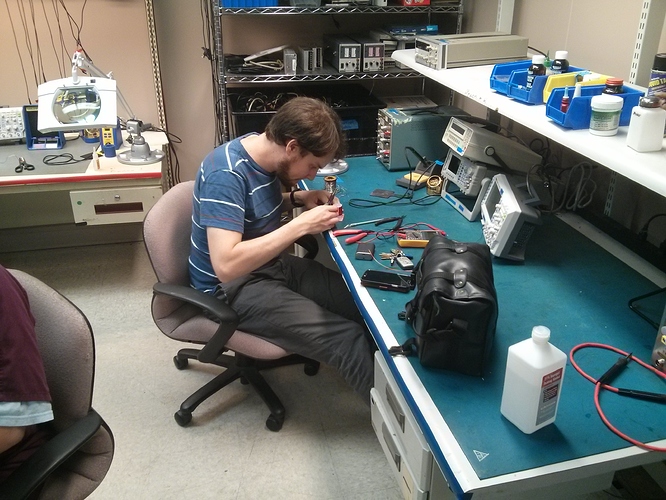Joh DL6ID and I have been exchanging e-mails in which we compare notes on the early homebrew television receiver of Johnny Anderson W9YEI. In 1973 on WOR New York, Jean Shepherd described a very memorable demonstration of TV conducted some three decades earlier by Anderson for teenage friends in Hammond, Indiana. Shep provided a lot of detail, but some of his recollections seemed a bit off; Shep was known for exaggerating or changing details to make a story better.
We have arrived at some conclusions about this project (but if anyone has more info, please let us know):
DID ANDERSON ACTUALLY BUILD A TV RECEIVER?
Yes, he did. This was a homebrew project, not a kit build and not the use of a receiver built and loaned for test purposes by the transmitting station. Anderson was an accomplished homebrewer whose basement, according to Shep, was filled with devices he had built. A QSL card sent by him in 1938 shows him using a "9 tube superhet" as a receiver. Shep describes Johnny -- over a period of perhaps six months -- gathering components in Chicago's electronics parts market, and building something in his basement. That sure sounds like a real homebrew project. A TV receiver kit was available, but it was very expensive, and Shep would have immediately denounced it as a non-homebrew project. Anderson homebrewed the receiver.
WHY DID HE DO THIS?
Why would a ham build a TV receiver at a time in which there were only a few experimental transmitters on the air, and no possibility of using the receiver to "work" other amateur stations? We tend to think of TV as a post-war commercial phenomenon. But in fact there was a lot of "buzz" about TV in the 1930s. Magazines were filled with TV articles, and with ads for courses that promised to prepare people for what seemed to many to be "the next big thing." The World's Fair in Chicago in 1933 and 1934 featured a demonstration of television -- Anderson, who lived in a close-in Chicago suburb, may have seen this demonstration. Television must have seemed like a do-able but difficult technical challenge, and would have attracted the interest of an advanced homebrewer like Anderson.
WHEN DID ANDERSON BUILD THE RECEIVER?
Shepherd describes a demonstration of TV in which Anderson tuned into experimental transmissions of WBKB in Chicago. WBKB's experimental transmitter W9XBK did not go on the air until August 1940. And Anderson told Shep that he had been calling in reception reports for a month or six weeks. That would push the date of the demonstration to September 1940 at the earliest. In September 1940 Anderson was 22 years old, and Shep was 19. (Here is one area in which Shep's recall is questionable -- he claims that the event took place when he -- Shep -- was 16 or 17. In fact he was older, but having the protagonists a bit younger made the story more intriguing.) If we assume that it took Anderson six months or so to build the receiver, that would push the start date of Anderson's build to around March 1940.
There was another experimental station on the air in Chicago: Zenith Corporation had W9XZV doing experimental transmissions starting on February 2, 1939. If Anderson had built the receiver a bit earlier, he could have been tuning into W9XVZ before W9XBK went on the air. But I think it was more likely that he started building in early 1940. I get the feeling that the Scozzari articles of October/November 1939 influenced his build.
WHAT PUBLICATIONS GUIDED ANDERSON?
Shep, in extolling Anderson's advanced, self-taught knowledge of electronics tells us that Anderson was at his young age already reading the IRE Journal, the monthly publication of the Institute of Radio Engineers. Joh DL6ID notes that Shep said that this publication was being sent to Anderson, indicating that he had some form of subscription. He may have also had access to back-issues in a Chicago library. Anderson was a serious consumer of technical material.
The IRE Journal had many articles about television, but they were highly theoretical. Typical of this was the December 1933 issue. Anderson probably also benefitted from more practical, build-related articles that appeared in publications like QST, Shortwave and Television, and Radio and Television.
In December 1937 QST began a series of articles on television my Marshall Wilder.
In March 1938 CW Palmer launched a series of build articles on TV receivers in the Gernsback magazine "Shortwave and Television." See photo below.
In October 1938 QST started a series of practical build articles on TV by J.B. Sherman. This series provided circuit details on how to use three different sizes of RCA oscilloscope CRTs, including the small 1 inch 913 tube.
In December 1938 QST continued with the television theme, presenting the first in a series of build articles by C.C. Schumard.
In October 1939 Peter Scozzari launched a good series of build articles in Radio and Television magazine. See photo below.
WHAT CATHODE RAY TUBE DID HE USE?
Many of the publications of the era carried projects using 2 or 3 inch CRTs. But it appears that Anderson had a smaller, 1 inch oscilloscope CRT in his project. In his 1973 broadcast, Shep repeatedly called the CRT "tiny" and refers to it as a 1 inch tube. Shep said the image produced was green, indicating a tube built for oscilloscopes. He may have used a 1 inch RCA 913 CRT Tube. See the Sherman article in the October 1938 QST.
THE DEATH OF ROSS HULL
In the middle of all this, on September 13, 1938 radio pioneer Ross Hull was electrocuted while working on his homebrew television receiver.



















